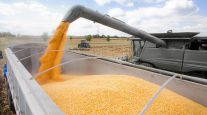Corn Heads Toward Worst Rout Since 2013 on Outlook for Acreage

[Stay on top of transportation news: Get TTNews in your inbox.]
Corn futures plunged by the exchange limit, heading for their worst day in at least six years, after the U.S. Department of Agriculture reported more of the grain was planted than analysts had estimated.
The USDA was criticized for releasing figures last month that didn’t fully reflect the delayed planting schedule because of heavy rains in the Midwest. The agency took the rare step of re-surveying farmers to get a more accurate number. In monthly figures released Aug. 12, it trimmed that initial estimate only by 1.7 million acres to 90 million. Analysts were expecting 87.7 million on average.
“Corn drops the limit with the USDA once again not cutting onto their estimates despite widespread expectations to do so,” INTL FCStone said in a note to clients. “Foul cries will continue.”
The United States faced one of the wettest planting seasons ever, delaying corn sowing by the most on record and leaving normally uniform fields totally uneven. Soybeans aren’t much better. Flowering is behind schedule and now that the weather has turned dry, plants are struggling to develop. Still, plants are proving to be resilient thanks to advances in seed technology and precision farming.
Corn futures for December delivery fell by the limit of 25 cents to $3.9275 a bushel on the Chicago Board of Trade. A close at the price would leave the price down 6%, a record for the contract and the steepest decline for most-active futures since at least May 2013.
Soybean futures also fell, but held up better than corn after the soy acreage number came in lower than expected. Extremely bearish corn is pulling soy down with it, said Terry Reilly, senior commodity analyst at Futures International.
“What I like out there is to see some soybean-corn spreading to kick in over the next day or two,” he said by phone. “We’ll continue to see weakness through the remainder of the balance of this week in the corn market.”
Tatiana Freitas, Michael Hirtzer and Lydia Mulvany contributed to this report.




